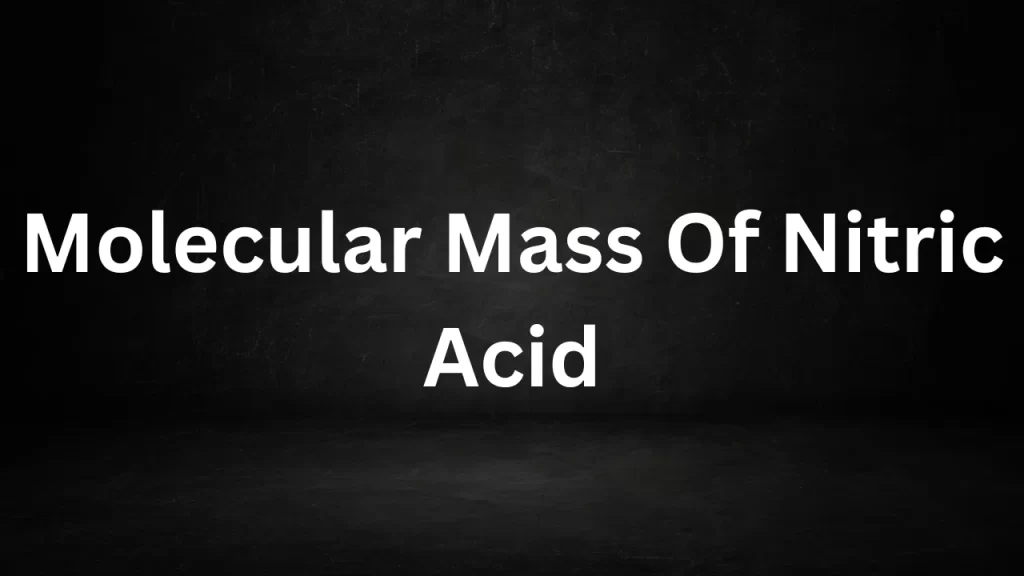Tag: hno3 molecular mass\
Molecular Mass Of Nitric Acid
Molecular Mass Of Nitric Acid: Nitric acid (HNO3) is a highly corrosive and essential chemical compound used in various industrial applications, including the production of fertilizers, explosives, and cleaning agents.
Understanding nitric acid’s molar mass is crucial in chemistry, impacting stoichiometry, reactions, and laboratory procedures significantly. This article delves into molecular mass, its significance in chemistry, and the calculation of nitric acid’s (HNO3) molecular mass.
Molecular Mass Of Nitric Acid
Molecular Mass: A Fundamental Concept
The Molecular mass, also known as mole weight or molar mass, is a fundamental concept in chemistry. It represents the mass of one mole of a substance and is expressed in atomic mass units (amu) or unified atomic mass units (u). The molecular mass of a compound is calculated by summing the atomic masses of all the atoms in its chemical formula, considering the number of atoms of each element.
Calculating the Molecular Mass of Nitric Acid
To find the molecular mass of nitric acid (HNO3), we sum the atomic masses of hydrogen (H), nitrogen (N), and oxygen (O) within the chemical formula.
- Hydrogen (H): The atomic mass of hydrogen is approximately 1.01 amu.
- Nitrogen (N): The atomic mass of nitrogen is approximately 14.01 amu.
- Oxygen (O): The atomic mass of oxygen is approximately 16.00 amu.
Now, let’s calculate the mole mass of nitric acid:
Molecular Mass of HNO3 = (1 × Atomic Mass of H) + (1 × Atomic Mass of N) + (3 × Atomic Mass of O) Molecular Mass of HNO3 = (1 × 1.01 amu) + (1 × 14.01 amu) + (3 × 16.00 amu) Molecular Mass of HNO3 = 1.01 amu + 14.01 amu + 48.00 amu Molecular Mass of HNO3 = 63.02 amu
So, the mole mass of nitric acid (HNO3) is approximately 63.02 amu.
Significance of Molecular Mass of Nitric Acid
The mole mass of nitric acid is significant for several reasons:Stoichiometry:
- It is crucial in stoichiometry, helping chemists balance chemical equations and calculate the amount of reactants and products involved in chemical reactions involving nitric acid.
- Laboratory Work: In laboratories, scientists use the mole mass to measure and prepare solutions of nitric acid with specific concentrations for experiments and analyses.
- Industrial Applications: Industries rely on the mole mass to ensure precise measurements and control processes involving nitric acid, such as in the production of fertilizers, explosives, and chemical manufacturing.
- Safety Precautions: Understanding the mole mass is essential for handling nitric acid safely, as it helps in determining appropriate safety measures and precautions due to its corrosive nature.
Conclusion
The molar mass of nitric acid (HNO3) is a fundamental concept in chemistry, with essential roles in labs and industries. Calculating molecular mass aids chemists in understanding nitric acid’s behavior and composition, ensuring precise control in chemistry and industry.
Read More
- Molecular Mass Of Sulphuric Acid
- Molar Mass Of Sulphuric Acid
- Types Of Motion In Physics
- Kinetic Energy Class 9
- Molecular Weight of AgNO3
Frequently Asked Questions (FAQs) On Molecular Mass Of Nitric Acid
1. What is the chemical formula for nitric acid?
The chemical formula for nitric acid is HNO3, representing one hydrogen atom (H), one nitrogen atom (N), and three oxygen atoms (O) in a single molecule.
2. What is molecular mass, and why is it important in chemistry?
Molecular mass, also known as mole weight or molar mass, is the mass of one mole of a substance expressed in atomic mass units (amu) or unified atomic mass units (u). It is crucial in chemistry as it helps determine the quantity of substances involved in chemical reactions and stoichiometry.
3. How is the molecular mass of nitric acid calculated?
The mole mass of nitric acid (HNO3) is calculated by adding the atomic masses of hydrogen (H), nitrogen (N), and oxygen (O) atoms in the chemical formula, considering their respective proportions.
4. What are the atomic masses of the elements in nitric acid?
The approximate atomic masses are:
- Hydrogen (H): 1.01 amu
- Nitrogen (N): 14.01 amu
- Oxygen (O): 16.00 amu
5. What is the molecular mass of nitric acid (HNO3)?
The mole mass of nitric acid is approximately 63.02 amu.
Nitric Acid Molar Mass
Nitric Acid Molar Mass: Nitric acid (HNO3) is a powerful and versatile chemical with a wide range of applications in industry, chemistry, and even explosives manufacturing. In this article, we will explore the molar mass of nitric acid, its molecular structure, and its significance in various chemical processes.

Nitric Acid Molar Mass
The Importance of Nitric Acid
Nitric acid, sometimes simply referred to as “nitrate,” is a highly corrosive and strong acid. It is a crucial reagent in many chemical reactions, including the production of fertilizers, explosives, dyes, and various other chemicals. Additionally, it is used in the etching of metals, pickling of stainless steel, and in the manufacturing of nitrate salts, which have applications in food preservation.
Molecular Structure of Nitric Acid
Before delving into the molar mass of nitric acid, let’s understand its molecular structure. Nitric acid has a simple yet distinctive chemical formula: HNO3. This formula represents one hydrogen (H) atom, one nitrogen (N) atom, and three oxygen (O) atoms bonded together.
In its molecular structure, the nitrogen atom is bonded to one oxygen atom through a single bond and to another oxygen atom through a double bond. The third oxygen atom is connected to the nitrogen atom via a single bond and also bonded to one of the other oxygen atoms through a double bond. The presence of these double bonds and the arrangement of atoms give nitric acid its unique properties.
Molar Mass of Nitric Acid
The molar mass of a compound is defined as the mass of one mole of molecules of that compound, measured in grams per mole (g/mol). To calculate the molar mass of nitric acid (HNO3), we sum the atomic masses of its constituent atoms:
- Hydrogen (H) has an atomic mass of approximately 1.01 g/mol.
- Nitrogen (N) has an atomic mass of approximately 14.01 g/mol.
- Oxygen (O) has an atomic mass of approximately 16.00 g/mol.
Now, let’s calculate the molar mass of nitric acid:
Mol Mass of Nitric Acid (HNO3) = (1 × Atomic Mass of Hydrogen) + (1 × Atomic Mass of Nitrogen) + (3 × Atomic Mass of Oxygen)
Molar Mass of Nitric Acid (HNO3) ≈ (1 × 1.01 g/mol) + (1 × 14.01 g/mol) + (3 × 16.00 g/mol)
Molar Mass of Nitric Acid (HNO3) ≈ 63.03 g/mol
So, the molar mass of nitric acid is approximately 63.03 grams per mole.
Significance of Molar Mass in Chemistry
The mol mass of nitric acid is a crucial value in chemistry. It allows chemists to determine the quantity of nitric acid needed for specific chemical reactions and ensures precise measurements when handling this powerful acid. Whether it’s in the production of fertilizers to enhance crop growth or in the synthesis of explosives, a clear understanding of nitric acid’s molar mass is essential for safe and effective chemical processes.
Conclusion
The mol mass of nitric acid, approximately 63.03 g/mol, is a fundamental parameter in the world of chemistry. It underlines the importance of this potent acid in various industrial processes and scientific applications, emphasizing the need for careful handling and precise measurements to harness its powerful reactivity safely and effectively.
Read More
- Molar Mass of Helium
- Molecular Mass of CH3COOH
- Molecular Weight of kmno4
- Molecular Weight of CaCO3
- Molecular Mass Of CaCO3
Frequently Asked Questions (FAQs) Nitric Acid Molar Mass
Q1: What is the mol mass of nitric acid?
A1: The mol mass of nitric acid (HNO3) is approximately 63.03 grams per mole (g/mol).
Q2: Why is the mol mass of nitric acid important in chemistry?
A2: The mol mass of nitric acid is crucial because it allows chemists to relate the mass of nitric acid molecules to the number of molecules present in a sample. This value is fundamental for stoichiometry, chemical calculations, and the formulation of chemical reactions, especially when working with nitric acid in various industrial processes.
Q3: What are the main applications of nitric acid in industry and chemistry?
A3: Nitric acid is used in various applications, including:
- Fertilizer production: It’s a key component in the manufacturing of ammonium nitrate, a common nitrogen fertilizer.
- Explosives production: Nitric acid is used in the synthesis of explosives like nitroglycerin and TNT.
- Dye production: It’s used in the production of dyes and pigments.
- Metals processing: Nitric acid is employed in metal etching, cleaning, and pickling.
- Food preservation: In the form of nitrate salts, it’s used for curing and preserving meats.
Q4: Is nitric acid a strong acid?
A4: Yes, nitric acid is considered a strong acid. It readily donates a hydrogen ion (H+) in aqueous solution, making it highly acidic and capable of reacting vigorously with other substances.
Q5: Can nitric acid be dangerous to handle due to its strength and corrosiveness?
A5: Yes, nitric acid is highly corrosive and can be dangerous to handle. It can cause severe burns, and its fumes can be harmful if inhaled. Proper safety precautions, including the use of appropriate protective equipment and careful handling, are essential when working with nitric acid.
